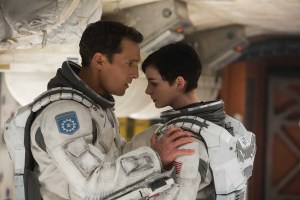
On a project of the magnitude of Interstellar, one conjures images of soundstages full of sets, floor plans, prop storage and myriad art department accoutrements. However, as with all of the latest Christopher Nolan films, Interstellar’s art department began in a humble place – Nolan’s home. “We always start in his house, in what was the hood of the garage,” said Interstellar’s production designer, Nathan Crowley. “The art department was started in Batman Begins and is now a nice art department. And so we have this space in his house in L.A. We always start here. They have some offices in there now. So it’s my favorite bit. Visual effects supervisor Paul Franklin is usually there; people come in like Hoyte Van Hoytema, cinematographer. He allows us to find the film visually, with him. And it is sort of a private four-six weeks – sometimes its eight weeks depending on the size of the film – where we actually try to discover what we want to say visually.”
In this low-stress pre-pre-production period, Crowley feels free to explore, preceding the immediate ramp-up into building the art department’s needs. “To figure out how we are going to go about the film and what it should look like, privately, allows me to then engage with 200-300 people, and I can instruct them correctly,” Crowley explained. “It’s streamlined, and we haven’t gone down any dead ends. That’s the way we have always done films. And it also allows me to do my work with Nolan. We draw together — he likes sketching as well. We have computers now, 3D printers, and we test ideas, and we have a mold shop, so I usually bring in a moldmaker or I bring in key people, such as an illustrator. At the same time, we look at locations, and we go ‘wondering.’ So we might fly to England and go look at a location, or we might fly to Iceland. And that allows us to go off and discuss the film in a place.”
 After the pre-pre-production period, Crowley moved out of Nolan’s house in to offices, and specifically into two enormous soundstages at Sony Pictures in Culver City to realize spaceship interiors and exteriors plus robots. “We sat at computers and created the ships digitally, and we made a model as well,” said Crowley. “That robot TARS needed to be modeled because he needed to be a thing that you can touch. And then we 3D printed it to test the ships shapes. We had a lot of ground to cover in a short amount of time.”
After the pre-pre-production period, Crowley moved out of Nolan’s house in to offices, and specifically into two enormous soundstages at Sony Pictures in Culver City to realize spaceship interiors and exteriors plus robots. “We sat at computers and created the ships digitally, and we made a model as well,” said Crowley. “That robot TARS needed to be modeled because he needed to be a thing that you can touch. And then we 3D printed it to test the ships shapes. We had a lot of ground to cover in a short amount of time.”
An art school alumnus, Crowley likened such an experience to the Interstellar design work with Nolan before shooting commenced. “It’s like going to art school for six-eight weeks doing fantastic stuff with a friend,” he related. “It’s just raw design. It’s incredibly busy because I got to do a bit of the Ranger; we got to figure out the Endurance, but what about that Tesseract? Give it to Paul Franklin; see what he can come up with. So you use whatever medium you need.
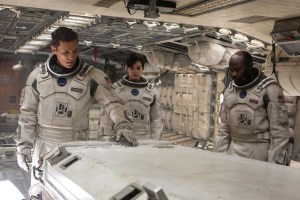 To realize the TARS robots, Crowley enlisted special effects coordinator Scott Fisher to work out the machine’s hydraulic doors. “We made TARS as a real puppeteering robot,” said Crowley. “So they had metal finishes and screens, and they were puppeteered by Bill Irwin from behind by hydraulics. It was important to bring Scott in and say how would you go about making this, because a lot of TARS is practical in this film. When you design robots, it’s difficult because there’s so many ideas about one. I definitely remember being with Chris and wondering if we were going to be brave enough to present the world with TARS. And so that was a great journey.”
To realize the TARS robots, Crowley enlisted special effects coordinator Scott Fisher to work out the machine’s hydraulic doors. “We made TARS as a real puppeteering robot,” said Crowley. “So they had metal finishes and screens, and they were puppeteered by Bill Irwin from behind by hydraulics. It was important to bring Scott in and say how would you go about making this, because a lot of TARS is practical in this film. When you design robots, it’s difficult because there’s so many ideas about one. I definitely remember being with Chris and wondering if we were going to be brave enough to present the world with TARS. And so that was a great journey.”
Surely, Interstellar featured numerous exotic locations all of which Crowley supervised in addition to building elements on stage. “We always try to think of everything that involves landscape,” he stated. “We go on ‘wondering trips;’ where are there giant bodies of water that are only two-foot deep, that we can actually work in all day and put a space ship in? There is one in Chile, but it is sunny and beautiful. And then there is Morecambe Bay in the North of England where again it would be a couple miles of water that was shallow, but it looked pretty miserable. We knew and worked in the glaciers in Iceland, but does it look enough like an ice planet? So, we thought, we either go to Chile and the Argentinean glaciers which Chris had already been to, and take a wondering trip down there, or start with a nearer place for us, so let’s go and look at Iceland and either rule it in or rule it out.”
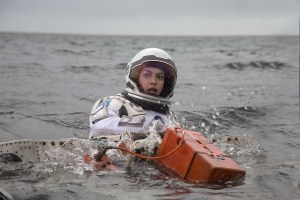 After settling upon Iceland for a key water planet, when Crowley moved into production, he transported his exterior spaceship elements there, mobilized by large cranes, plus hydraulic landing gears and hydraulic doors, so that actors could realistically disembark into the terrain. “We had to build a five-mile road down to the water, and a couple a miles up to the glacier to get the ships in,” Crowley specified of his ship pieces, 20-feet long and two-feet wide. “We built them here in LA and flew them on jumbo jets over. And so it was a big deal, but then you get it all in camera. Does it cost any more than a stage? Probably not, because you don’t have all the costs of being on a stage or in a tank. That gives you something that is kind of visceral, that you feel in the film because you lose control of it. And that’s what I love the best. My favorite photography is when the weather comes in and it like pounds you, and, on film, it always reads as less as when you are there because film cleans it up a bit.”
After settling upon Iceland for a key water planet, when Crowley moved into production, he transported his exterior spaceship elements there, mobilized by large cranes, plus hydraulic landing gears and hydraulic doors, so that actors could realistically disembark into the terrain. “We had to build a five-mile road down to the water, and a couple a miles up to the glacier to get the ships in,” Crowley specified of his ship pieces, 20-feet long and two-feet wide. “We built them here in LA and flew them on jumbo jets over. And so it was a big deal, but then you get it all in camera. Does it cost any more than a stage? Probably not, because you don’t have all the costs of being on a stage or in a tank. That gives you something that is kind of visceral, that you feel in the film because you lose control of it. And that’s what I love the best. My favorite photography is when the weather comes in and it like pounds you, and, on film, it always reads as less as when you are there because film cleans it up a bit.”
Four hours from the watery Iceland location, Crowley created the illusion of a wholly different planet on one of Iceland’s glaciers. “One night we had to take the Ranger out of the water planet and up to the glaciers,” he said. “We wanted to take it in one piece, because we had to film it a few days after. We spent the weekend to move it. We were cutting down signposts as we drove because it was wider than the road, and then re-welding them as we went by. We could slowly move it about 15 miles up to the glaciers. I get huge pleasure out of the construction and the task and mounting the climb. I find that extremely exciting. When building these sets, I just love seeing these things come into play.”
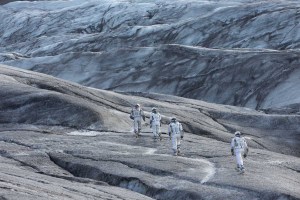 At its peak, Crowley’s department numbered 300, including an art department supervisor and several art directors. For the opening scenes on a future failing earth, Crowley built a house outside of Calgary, Alberta, Canada, including 500 acres of actual corn. “It was in an area where you don’t grow corn, and the farmer wanted to experiment,” Nolan relayed, “and he said, ‘Well it might fail,’ and we said, ‘What does failed corn look like?’ And he said, ’Well, it’s only going to be about 4 or 5 feet high.’ Perfect, we want it to fail! Because in the story, it’s not going well. We don’t want 10-foot corn.”
At its peak, Crowley’s department numbered 300, including an art department supervisor and several art directors. For the opening scenes on a future failing earth, Crowley built a house outside of Calgary, Alberta, Canada, including 500 acres of actual corn. “It was in an area where you don’t grow corn, and the farmer wanted to experiment,” Nolan relayed, “and he said, ‘Well it might fail,’ and we said, ‘What does failed corn look like?’ And he said, ’Well, it’s only going to be about 4 or 5 feet high.’ Perfect, we want it to fail! Because in the story, it’s not going well. We don’t want 10-foot corn.”
Back on Stage 27 at Sony, Crowley built the surreal black hole environs of the Tesseract. “We build a huge portion where Matthew goes to the bookshelf and the stress furniture,” said Crowley. “That was a tricky one to build, and obviously we had huge visual effects extensions on it. That was about 120 feet by 90 feet. And it had all those rooms, so we had to sculpt all these books vertically on the x, y, z-axis. And then it was all hung; it was like an art piece or art installation. The flow of the books was all painted and printed like wallpaper. And then Paul Franklin projected texture on it, so it felt like it would move. Special effects made the books go in and out up to like 20 feet high. I’ve never had a set like it and never will again. And Chris was determined to build as much as we could. Really, we carried on stretching out furniture until we ran out of time. We also had the Ranger Interiors and the Lander Interiors on 27.”
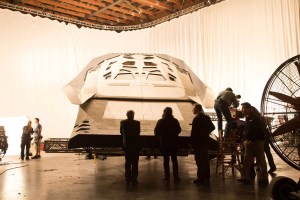 On Sony’s Stage 30 was a 150-foot gimbal with separate 50-foot pallets all on hydraulics for the scenes inside the Endurance spacecraft, the result of 12 weeks of construction. “We had obviously the navigation, cockpit, communications, the hyper-sleep pod, and then we had a living quarters pod,” Crowley related. “We had copies of those pods standing vertically, so we could get them floating around in the pods in a zero-G element. So a lot of sets had to be built twice, and then stood up vertically.”
On Sony’s Stage 30 was a 150-foot gimbal with separate 50-foot pallets all on hydraulics for the scenes inside the Endurance spacecraft, the result of 12 weeks of construction. “We had obviously the navigation, cockpit, communications, the hyper-sleep pod, and then we had a living quarters pod,” Crowley related. “We had copies of those pods standing vertically, so we could get them floating around in the pods in a zero-G element. So a lot of sets had to be built twice, and then stood up vertically.”
To enhance Crowley’s sets, serving as Interstellar’s set decorator was veteran Gary Fettis. “It was the project of a lifetime really,” Fettis stated. “You know the way Chris Nolan works and Nathan Crowley: they have a war room where it is very secretive. But it’s their brainchild, the layout of the movie and the design of the film, and once I got to be a part of that and see what they were planning, it was fascinating. It just gets you to the point where you can’t wait to get started. And the power behind Chris Nolan, his belief in his story and his bit of story telling, and the magic in this film was compelling. It was an incredible experience.”
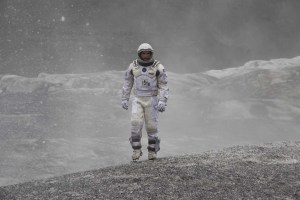 For his preparation period, Fettis had 22 weeks, which he related was “just enough” time to amass his wares for a project of the immensity that Interstellar would become. “But immediately once I read the script, I was assigned, I walked into the war room and Nathan walked me through it,” Fettis said. “And then I went and put my crew together and brought in the right people to do the job, and it wasn’t like everything was going to be solved right away. We knew it was going to take on an organic shape and be an evolutionary process where we collect the elements. It was determined earlier by Chris that this wasn’t going to be futuristic – that it was grounded in NASA – what it is today. We were trying to recreate these big ships like the Endurance and the Ranger, and to try to do those was a daunting process, but it finally got done.”
For his preparation period, Fettis had 22 weeks, which he related was “just enough” time to amass his wares for a project of the immensity that Interstellar would become. “But immediately once I read the script, I was assigned, I walked into the war room and Nathan walked me through it,” Fettis said. “And then I went and put my crew together and brought in the right people to do the job, and it wasn’t like everything was going to be solved right away. We knew it was going to take on an organic shape and be an evolutionary process where we collect the elements. It was determined earlier by Chris that this wasn’t going to be futuristic – that it was grounded in NASA – what it is today. We were trying to recreate these big ships like the Endurance and the Ranger, and to try to do those was a daunting process, but it finally got done.”
Using reference photos from NASA photographs, Fettis loosely structured his interior ships and while leadperson Mark Weissenfluh lead a crew to retrieve objects which would be dressed into the set. On Interstellar, 20% of the elements within the set were rentals, 40% was the result of manufacturing, and 40% were pieces that were purchased. “We just started collecting at that point, all around Los Angeles, gathering parts from aviation warehouses – components and switches and panels and things,” said Fettis. “Gang boss Kevan Weber and model maker Adam Mull and the shop supervisor David Klassen were very talented guys. He had all his tools and a big workshop, ready with mold makers and electronics people. And we just started manufacturing as we started to get drawings and sections. Set designers would come in, and we would have shelves of parts, and they would grab things. Nathan would have them, ‘Okay you create section A. You can work off this shelf and then pull their stuff over.’ And then draw it up, like panels and gauges, and then I would put some set dressers on it to build it out in pieces. And we pieced it together like a large model.”
For Fettis, this unique project represented the culmination of the breadth of his career-spanning efforts as a set decorator. “The level of enjoyment was in the reward of seeing these magnificent pieces come together,” he revealed, “and just see the actors go in there and get blown away, like they really felt they were in that environment. And that was rewarding, more than anything I’ve ever done.”





